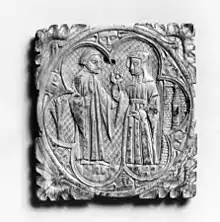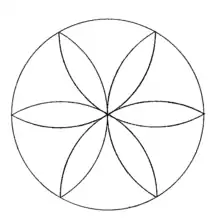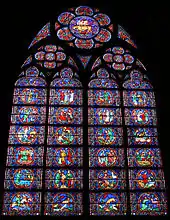Hexafoil
A hexafoil is a geometric design that is used as a traditional element of Gothic architecture,[1] created by overlapping six circular arcs to form a flower-like image.[2][3] The hexafoil design is modeled after the six petal lily, for its symbolism of purity and relation to the Trinity.[4] The hexafoil form is created from a series of compound units, and exists as a more complex variation of the same extruded figure.[5] Other forms similar to the hexafoil include the trefoil, quatrefoil, and cinquefoil.[6]

Creating a hexafoil

One common form of the hexafoil has a ring of six tangent circles circumscribed by a larger circle. It may be constructed by compass and straightedge, by drawing six circles at the centers of a regular hexagon, with diameter equal to the side of the hexagon.[7] The inner circles of the hexafoil have radius 1/3 that of the outer circle containing them, from which it is possible to derive the area and perimeter of the figure as a mathematical exercise.[8]


Another method of drawing a hexafoil is the vesica piscis method. To do so one takes a ruler and uses it to draw a line. A compass is used to draw a circle. The needle point is put on the point where the perimeter of the circle intersects the horizontal and the drawing point on the center of the circle to draw a curved line that intersects two points of the perimeter of the circle. This makes the vesica piscis shape. The needle point of the compass is then put on the points where the vesica piscis intersects the perimeter of the circle and another semi circle is drawn, terminating at the perimeter. One then continues drawing the semi-circles at the points where they intersect with the circle's perimeter until all points are connected and the shape is a hexafoil.
Architecture
A key component to Gothic architecture is a strong design principal involving geometry and harmony.[4] The hexafoil design is implemented in various Gothic buildings constructed in the 12th through 16th century. The traditional design is used in cloisters, triforiums and stained glass windows of famous buildings such as Notre-Dame, Salisbury Cathedral, and Regensburg Cathedral.[9] Stone cut-out hexafoils are displayed in a plate tracery style in the Salisbury Cathedral, creating a pattern along the triforium.[10]
Religion
The hexafoil form can also be see as a framing design in Bible moralisée.[11] They are often rendered in red, blue, gold or vibrant orange and surround biblical scenes in the bible.[11][12] The hexafoil style of framing was often used in conjunction with architectural framing to provide the text with more depth, creativity, invention, and volume.[11] Old Testament illustrations were surrounded by hexafoil frames while moralization depictions favored architectural frames.[12]
Magic
Hexafoil designs are known to have links to folk magic practices in various countries, including the United Kingdom and Australia, where a six leaf design with concentric circles have been found in homes and occasionally in public buildings to serve as a sign of protection.[13][14]
References
- Hartop, Christopher; Norton, Jonathan (2008), Geometry and the silversmith: the Domcha Collection, John Adamson, ISBN 9780952432289,
The trefoil, quatrefoil, hexafoil and octofoil, essential elements of Gothic architecture, all figure in medieval silver.
- Passmore, Augustine C. (1904), Handbook of Technical Terms Used in Architecture and Building and Their Allied Trades and Subjects, Scott, Greenwood, and Company, p. 178,
A geometrical figure used in tracery; it is composed of six lobes or parts of circles joining each other.
- Rugoff, Milton (1976), The Britannica encyclopedia of American art: a special educational supplement to the Encyclopædia Britannica, Encyclopædia Britannica Educational Corp., p. 636,
A geometrical figure with six lobes, used as the form of a silver platter or a wooden decorative panel.
- Laxton, William (1856). The Civil Engineer and Architect's Journal. Published for the proprietor.
- Griffith, William Pettit (1845). The Natural System of Architecture, as Opposed to the Artificial System of the Present Day. Gilbert and Rivington.
- Chiffriller, Joe (2002). "Tips & Tricks to Gothic Geometry" (PDF). New York Carver – via PBworks.
- Spanton, John Humphrey (1895), Science and Art Drawing: Complete Geometrical Course; Consisting of Plane and Solid Geometry, Orthographic and Isometric Projection, Projection of Shadow's the Principles of Map Projection, Graphic Arithmetic and Graphic Statics, Macmillan, p. 56.
- Betz, William; Webb, Harrison Emmett; Smith, Percey Franklyn (1912), Plane Geometry, Mathematical texts for school, Ginn, p. 321.
- "The World's Best Photos of hexafoil - Flickr Hive Mind". hiveminer.com. Retrieved 2018-11-12.
- "Salisbury Cathedral". Khan Academy. Retrieved 2018-11-17.
- Husband, Timothy B. (2008). The Art of Illumination: The Limbourg Brothers and the Belles Heures of Jean de France, Duc de Berry. Metropolitan Museum of Art, Yale University Press. p. 282. ISBN 9781588392947.
hexafoil in architecture.
- "Microfilms and Fascimilies Database // Medieval Institute Library // University of Notre Dame". medieval-microfilms-and-facsimiles.library.nd.edu. Archived from the original on 2019-07-28. Retrieved 2018-11-12.
- Mysterious hexafoil markings in Australian homes point to hidden magical past, Nicole Dyer and Damien Larkins, ABC News Online, 2017-02-22
- Evans, Ian J. "Defence Against the Devil: Apotropaic Marks in Australia". Cite journal requires
|journal=(help)